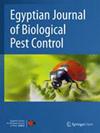毒死蜱和球孢白僵菌在埃及甜菜田的应用评价:对沿海夜蛾及其相关捕食者种群和甜菜根产量的影响
IF 2.1
3区 农林科学
Q1 ENTOMOLOGY
引用次数: 0
摘要
摘要背景害虫和天敌对常规杀虫剂的敏感性是判断害虫综合治理方案成功与否的关键因素。本研究通过连续两个甜菜季的田间应用,评价了棉花叶虫(鳞翅目:夜蛾科)对有机磷杀虫剂(毒死蜱)和昆虫病原真菌白僵菌的敏感性。对瓢虫类、蝶类和蚁类捕食者的种群数量进行了估计,以指导农药风险评估策略。在整个试验期间比较了根产量和糖产量,以强调两种控制策略对该战略作物收获前损失的影响。结果在调查的两个季节中,毒死蜱显著降低了滨小绥螨及其伴生捕食者的种群密度。与未处理区相比,处理后的第1季和第2季滨海夜蛾幼虫数量分别减少97%和92%。以球孢白僵菌(Beauveria bassiana)为基础的生物农药在第1季和第2季对滨海白僵菌的总体抑制率分别达到96%和65%。与无药区相比,球孢白僵菌对食用菌种群的影响较小,因此建议在甜菜田施用球孢白僵菌对相关食用菌的危害不大。两个生长季节,与未处理地块相比,两种处理的甜菜根产量和含糖量均显著增加。结论毒死蜱不宜用于害虫防治;相反,作为综合虫害管理计划的一部分,球孢白僵菌被认为是一种有效的生物农药,可以在埃及甜菜田感染滨海白僵菌。它们的直接作用是减少害虫数量,间接作用是增加甜菜根产量和总含糖量。因此,在甜菜根的质量和数量上,施用微生物剂比施用化学杀虫剂更有利于减少甜菜根对相关捕食者的化学危害。本文章由计算机程序翻译,如有差异,请以英文原文为准。
Evaluation of chlorpyrifos and Beauveria bassiana as a strategy in the Egyptian sugar beet fields: impact on Spodoptera littoralis (Boisduval) and its associated predators populations and the sugar beetroot yield
Abstract Background The susceptibility of pests and natural enemies to conventional insecticides is a critical element in judging the success of integrated pest management programs implementing biological control as a tactic. In this study, the susceptibility of the cotton leafworm Spodoptera littoralis (Boisd.) (Lepidoptera: Noctuidae) to an organophosphorus insecticide (chlorpyrifos) and the entomopathogenic fungus Beauveria bassiana was evaluated through field applications during two successive sugar beet seasons. The populations of the coccinellid, chrysopid, and formicid predators were estimated to indicate pesticide risk assessment strategy. The root and sugar yields were compared during the whole experiment to emphasize the impact of both control strategies on the pre-harvest loss in this strategic crop. Results Results indicated that over the course of the two seasons of the investigation, chlorpyrifos significantly reduced the population density of S. littoralis and its associated predators. It showed a detrimental effect on S. littoralis larval population than untreated areas, causing an overall reduction of 97 and 92% during the 1st and 2nd seasons, respectively. The biopesticide based on entomopathogenic fungus Beauveria bassiana caused an overall reduction of S. littoralis , reaching 96 and 65% during the 1st and 2nd seasons, respectively. Meanwhile, B. bassiana slightly affects the population of predators compared to insecticide-free areas, so it was recommended for application in sugar beet fields without providing considerable risk to the associated insect predators. The sugar beetroot production and its sugar content increased significantly in both treatments during the two growing seasons compared to non-treated plots. Conclusion Chlorpyrifos is not recommended for pest control; instead, B. bassiana is considered an effective biopesticide in the Egyptian sugar beet fields infested with S. littoralis as part of an integrated pest management program. Their effect was direct through reducing pest population and indirectly increasing the sugar beetroot production and increasing its total sugar content. Hence, both the sugar beetroot quality and quantity were improved favoring the microbial agent over the chemical insecticide in application for mitigating the chemical hazards toward the associated predators.
求助全文
通过发布文献求助,成功后即可免费获取论文全文。
去求助
来源期刊
CiteScore
4.90
自引率
16.70%
发文量
128
审稿时长
>12 weeks
期刊介绍:
The Egyptian Journal of Biological Pest Control is a periodic scientific journal published by the Egyptian Society for Biological Control of Pests (ESBCP) in collaboration with SpringerNature. The journal aims to publish internationally peer-reviewed, high-quality research articles in the field of biological and integrated pest control (non-chemical control). The journal publishes review articles, original papers, conference reports, book reviews, editorials, laboratory reports, technical notes and short communications.

 求助内容:
求助内容: 应助结果提醒方式:
应助结果提醒方式:


